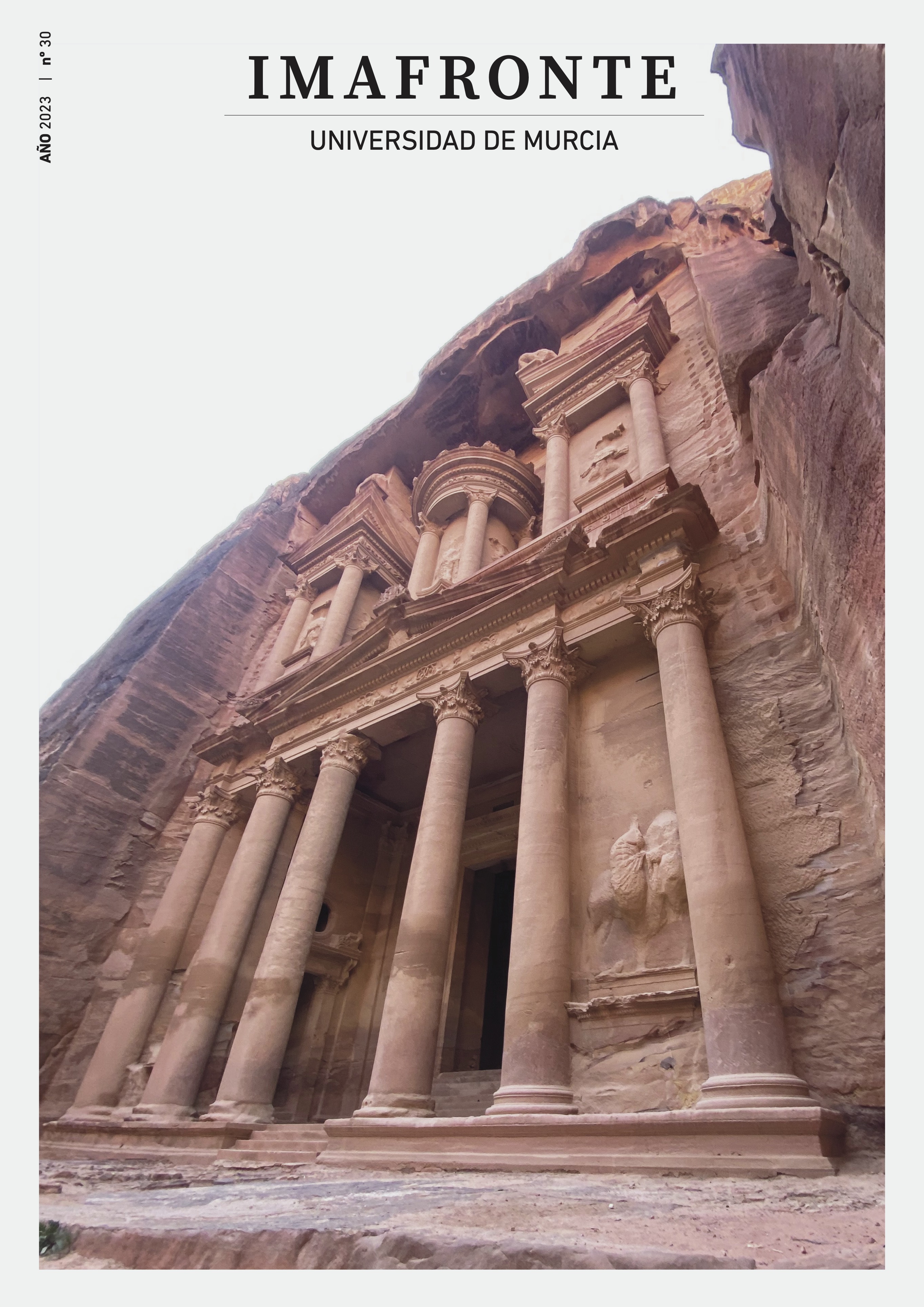Figural graffiti from the basilica of St. Philoxenos at Oxyrhynchus (El-Bahnasa, Egypt)
Resumen
Oxyrhynchus represents a key settlement for understanding the phenomena of continuity and transformation in the long transition to Christianity. The importance of this city and its religious panorama even after the Islamic conquest is testified by the wealth of textual and archaeological evidence unearthed over more than one century of archaeological investigations. New essential testimonies are offered by the excavations carried out since 2013 by the Mission of the University of Barcelona within the area of a Christian religious complex (Sector 24), which has led to the discovery of a rich corpus of figural and textual graffiti. Some of this evidence was found painted or scratched on stone slabs, which were probably used in antiquity to seal the underground galleries of this religious building. After a brief introduction to the history of the site and the aforementioned Christian complex, the present contribution will offer an overview of a group of figural graffiti discovered in this area. Their examination in light of the textual and archaeological sources offered by this settlement and considering the parallels provided by other contemporary cultic spaces will offer some glimpses into the social and cultic background of the devotees visiting the holy site and leaving a trace of their passage on the walls of this sanctuary.
Descargas
-
Resumen934
-
EPUB370
-
PDF525
Citas
Bagnall, R. (1993). Egypt in Late Antiquity. Princeton: Princeton University Press.
Bastianini, G., & Casanova, A. (eds.). (2009). 100 anni di istituzioni fiorentine per la papirologia: Atti del convegno internazionale di studi, Firenze, 12-13 giugno 2008. Firenze: Firenze University Press.
Bolman, E. S. (ed.). (2016). The Red Monastery Church: Beauty and Asceticism in Upper Egypt. New Haven-London: Yale University Press.
Breccia, E. (1933). Municipalité d’Alexandrie: Le Musée gréco-romain, 1931-1932. Bergamo: Istituto italiano d’arti grafiche.
Breccia, E. (1934-1937). Un cronos mitriaco ad Oxyrhynchos. In P. Jouguet (ed.), Mélanges Maspero, vol. II: Orient grec, romain et byzantin. Mémoires publiés par les membres de l'Institut français d'archéologie orientale, 67/2. Cairo: Institute français d'archéologie orientale, 257-264.
Caruso, J.H. (1986). Lophiidae. In P.J.P. Whitehead, M.-L. Bauchot, J.-C. Hureau, J. Nielsen, & E. Tortonese (eds.), Fishes of the North-Eastern Atlantic and the Mediterranean, Volume 3. Paris: Unesco, 1362-1363.
Cipriano, G. (2008). El-Bagawat: Un cimitero paleocristiano nell’Alto Egitto. Todi: Tau.
Cruz-Uribe, E. (2008). Graffiti (Figural). In W. Wendrich (ed.), UCLA Encyclopedia of Egyptology, Los Angeles. Available online: http://www.escholarship.org/uc/item/7v92z43m [last access 19/12/2022].
Delattre, A. (2017). Minima epigraphica. In R. Pintaudi (ed.), Antinoupolis III: Scavi e Materiali. Volume 2. Firenze: Firenze University Press, 493-508.
Denon, V. (1802). Voyage dans la Basse et la Haute Égypte, pendant les campagnes du général Bonaparte. Paris: L'Imprimerie de P. Didot l'Aine.
Depuydt, L. (1993). Catalogue of Coptic Manuscripts in the Pierpont Morgan Library. Leuven: Peeters.
DiBiasie-Sammons, J. F. (2022). Qui carbone rudi putrique creta scribit: The Charcoal Graffiti of Herculaneum. American Journal of Archaeology, 126/3, 385-410.
Dijkstra, J. (2009). Structuring Graffiti: The Case of the Temple of Isis at Aswan. In R. Preys (ed.), Ägyptologische Tempeltagung: Structuring Religion. Wiesbaden: Harrassowitz Verlag, 77-93.
Dijkstra, J. (2010). The Reuse of the Temple of Isis at Aswan as a Church in Late Antiquity. Journal of the Canadian Society for Coptic Studies, 1, 33-46.
Dijkstra, J. (2012). Syene I: The Figural and Textual Graffiti from the Temple of Isis at Aswan, Beiträge zur Ägyptischen Bauforschung und Altertumskunde, 18. Mainz: Philipp von Zabern.
Dijkstra, J. (2013). Graffiti als tekens van persoonlijke devotie in het Oude Egypte. Ta-Mery, 6, 54-71.
Erroux-Morfin, M., & Padró Parcerisa, J. (2008). Oxyrhynchos, un site de fouilles en devenir: Colloque de Cabestany, avril 2007. Barcelona: Publicacions de la Universitat de Barcelona.
Gabra, G. (1993). Cairo: The Coptic Museum and Old Churches. Cairo: The Egyptian International Publishing Company - Longman.
Gabra, G. (2007). The Treasures of Coptic Art: In the Coptic Museum and Churches of Old Cairo. Cairo: The American University in Cairo Press.
Gonis, N. (2003). Ship-Owners and Skippers in Fourth Century Oxyrhynchus. Zeitschrift für Papyrologie und Epigraphik, 143, 163-165.
Grenfell, B. (1897). Oxyrhynchus and Its Papyri. In. F. Llewellyn Griffith (ed.), Egypt Exploration Fund: Archaeological Report 1896-1897. London: Egypt Exploration Fund, 1-12.
Grenfell, B., & Hunt, A. (1907). Graeco-Roman Branch: Excavations at Oxyrhynchus. In F. Llewellyn Griffith (ed.), Archaeological Report (Egypt Exploration Fund): 1906-1907. London: Egypt Exploration Fund, 8-11.
Griffin, C. W., & Paulsen, D. (2002). Augustine and the Corporeality of God. Harvard Theological Review, 95(1), 97-118.
Grossmann, P. (2002). Christliche Architektur in Ägypten. Handbook of Oriental Studies, 62. Leiden-Boston-Köln: Brill.
Gutmann, J. (1988). The Dura Europos Synagogue Paintings and Their Influence on Later Christian and Jewish Art. Artibus et Historiae, 9/17, 25-29.
Innemée, K. C. (1992). Ecclesiastical Dress in the Medieval Near East. Studies in Textile and Costume History, 1. Leiden-New York-Köln: Brill.
Keenan, J. G. (1977). The Provincial Administration of Egyptian Arcadia. Museum Philologicum Londiniense, 2, 193-202.
Leclant, J. (1984). Fouilles et travaux en Égypte et au Soudan, 1982–1983. Orientalia, 53(3), 350-416.
Leclant, J., & Clerc, G. (1985). Fouilles et travaux en Égypte et au Soudan, 1983-1984. Orientalia, 54(3), 337-415.
Leclant, J., & Clerc, G. (1986). Fouilles et travaux en Égypte et au Soudan, 1984-1985. Orientalia, 55(3), 236-319.
Mascia, L., & Martínez García, J. J. (2021). A New Christian Epitaph from Oxyrhynchus. Zeitschrift für Papyrologie und Epigraphik, 218, 139-141.
Mascort Roca, M. (2016). L’Osireion d’Oxirrinc (El Bahnasa, Egipte). Estudi arqueològic i dels rituals del culte a Osiris entre els segles VII aC i II dC. [Ph.D. Thesis, Universitat de Barcelona].
Masri, I. (1982). The Story of the Copts, The True story of Christianity in Egypt, Book 1, From the Foundation of the Church by Saint Mark to the Arab Conquest. California: M. Merry Springs.
Mossakowska-Gaubert, M. (2023). Le vêtement monastique en Égypte (IVe-VIIIe siècle). Bibliothèque d'études coptes, 28. Cairo: Institut français d’archéologie orientale.
Murray, M. A., Milne, J. G., & Crum, W. E. (1904). The Osireion at Abydos. London: B. Quaritch Collection.
Murray, P., & Murray, L. (1996). The Oxford Companion to Christian Art and Architecture. Oxford: Oxford University Press.
Muus, B., & Dahlström, P. (1978). Meeresfische der Ostsee, der Nordsee, des Atlantiks: Biologie, Fang, wirtschaftliche Bedeutung. München: BLV Bayer.
Osharina, O. (2013). The Image of the Lion in Coptic Art. Journal of Coptic Studies, 15, 95-116.
Padró i Parcerisa, J. (ed.). (2007). Fouilles Archéologiques à El-Bahnasa. Barcelona: Publicacions i Edicions de la Universitat de Barcelona.
Padró i Parcerisa, J., Algorri, E., Amer, H. I., Campillo Quintana, J., Castellano, N., Codina Reina, D., Erroux-Morfin, M., Mangado, M. L., Martínez García, J. J., Mascort Roca, M., Pons Mellado, E., & Subías, E. (2009). Memòria provisional dels treballs realitzats en el jaciment d’Oxirrinc (El-Bahnasa, Provincia de Mínia, Egipte) durant la campanya de 2009. Nilus, 18, 3-26.
Padró, J., Amer, H., Campillo, J., Castellano, N., Erroux-Morfin, M., Mangado, M.L., Martínez, J. J., Mascort, M., Pons, E., Riudavets, I., Subías, E., (2010). Informe preliminar dels treballs d’excavació i restauració realitzats al jaciment d’Oxirrinc (El-Bahnasa, Mínia) durant la campanya de 2010. Nilus, 19, 3-12.
Padró i Parcerisa, J., Agustí, B., Amer, H. I., Castellano, N., Codina Reina, D., Erroux-Morfin, M., Martínez García, J. J., Mascort Roca, M., Pons Mellado, E., Riudavets, I., & Van Neer, W. (2013). Informe preliminar dels treballs arqueològics realitzats a Oxirrinc (El-Bahnasa, Mínia, Egipte) durant la campanya de 2013. Nilus, 22, 3–15.
Padró, J., Algorri, E., Amer, H., Burgaya, B., Castellano, N., Codina, D., Aguizy, O. E.-, Erroux-Morfin, M., Goyon, J.-C., Hamza, M., Martínez, J. J., Mascort, M., Perraud, A., Piedrafita, C., Pons, E., & Xarrié, R. (2014). La tombe No 1 à la Nécropole Haute (Vol. 8). Barcelona: Publicacions i Edicions de la Universitat de Barcelona.
Padró i Parcerisa, J., Agustí, B., Amer, H. I., Burgaya, B., López, A., Martínez García, J. J., Mascort Roca, M., & Pons Mellado, E. (2018). Memòria provisional dels treballs realitzats durant la campanya de 2017-2018 a El Bahnasa, Oxirrinc (Minia, Egipte). Nilus, 27, 3-12.
Padró i Parcerisa, J., Agustí, B., Amer, H. I., Burgaya, B., López, A., Martínez García, J. J., Mascort Roca, M., Pons Mellado, E., & Riudavets, I. (2020). Memòria d’excavació febrer-març 2019 a Oxirrinc (Mínia, Egipte). Nilus, 28, 4-26.
Padró i Parcerisa, J., Martínez García, J. J., & Piedrafita Carpena, C. (2018). Historia de un edificio religioso en Oxirrinco, desde el s. IV a.C. hasta el s. VII d.C. Anuari de Filologia. Antiqva et Mediaevalia, 8, 702-718.
Papaconstantinou, A. (1996). La liturgie stationnale à Oxyrhynchos dans la première moitié du 6e siècle: Réédition et commentaire du POxy XI 1357. Revue des études byzantines, 54(1), 135-159.
Papaconstantinou, A. (2001). Le culte des saints en Égyptes des Byzantins aux Abbassides. L’apport des sources papyrologiques et épigraphiques grecques et coptes. Paris: CNRS.
Papaconstantinou, A. (2005). La reconstruction de Saint-Philoxène à Oxyrhynchos: L’inventaire dressé par Philéas le tailleur de pierres. In F. Baratte, V. Déroche, C. Jolivet-Lévy, & B. Pitarakis (eds.), Mélanges Jean-Pierre Sodini. Travaux et Mémoires du Centre de Recherche d'Histoire et Civilisation de Byzance, 15. Paris: Association des Amis du Centre d'Histoire et Civilisation de Byzance, 183-192.
Papini, L. (1990). Struttura e prassi delle domande oracolari in greco su papiro. Analecta papyrologica, 2, 11-20.
Papini, L. (1992). Domande oracolari: elenco delle attestazioni in greco ed in copto. Analecta papyrologica, 4, 21-27.
Paulsen, D. (1990). Early Christian Belief in a Corporeal Deity: Origen and Augustine as Reluctant Witnesses. Harvard Theological Review, 83(2), 105-116.
Petrie, W. M. F., Gardiner, A., Petrie, H., & Murray, M. A. (1925). Tombs of the Courtiers and Oxyrhynkhos. London: British School of Archaeology in Egypt.
Piankoff, A. (1958-1960). The Osireion of Seti I at Abydos During the Greco-Roman Period and the Christian Occupation. Bulletin de la Société d’Archéologie copte, 15, 125-149.
Pietsch, T. W. (2009). Oceanic Anglerfishes: Extraordinary Diversity in the Deep Sea. Berkeley: University of California Press.
Pintaudi, R. (2007). The Italian Excavations. In A. K. Bowman, R. A. Coles, N. Gonis, D. Obbink, & P. J. Parsons (eds.), Oxyrhynchus: A City and Its Texts. Graeco-Roman Memoirs, 93. London: Egypt Exploration Society, 104-108.
Pintaudi, R. (2017). Graffiti e iscrizioni sulle colonne e i capitelli della chiesa D3 ad Antinoupolis. In R. Pintaudi (ed.), Antinoupolis III: Scavi e Materiali. Volume 2. Firenze: Firenze University Press, 459-487.
Pons Mellado, E. (2021). Tumba monumental de época Saíta de la Necrópolis Alta. Barcelona: Publicacions i Edicions de la Universitat de Barcelona.
Pope, J. (2019) Figural Graffiti from the Meroitic Era on Philae Island. In G. Emberling, & S. Davis (eds.), Graffiti as Devotion: Along the Nile and Beyond, Kelsey Museum Publication, 16. Ann Arbor: Kelsey Museum of Archaeology, 71-86.
Rasimus, T. (2012). Revisiting the Ichthys: A Suggestion Concerning the Origins of Christological Fish Symbolism. In C. Bull, L. Ingeborg, & J. Turner. (eds.), Mystery and Secrecy in the Nag Hammadi Collection and Other Ancient Literature: Ideas and Practices. Nag Hammadi and Manichaean Studies, 76. Leiden: Brill, 327-348.
Schiller, G. (1971). Iconography of Christian Art. New York: New York Graphic Society.
Strzygowski, J. (1904). Koptische Kunst: Catalogue général des antiquités égyptiennes du Musée du Caire Nos 7001-7394 et 8742-9200. Wien: Imprimerie Adolf Holzhausen.
Subías Pascual, E. (2003). La corona immarcescibile: Pintures de l'antiguitat tardana de la necròpolis alta d'Oxirinc (Mínia, Egipte). Documenta, 1. Tarragona: Institut Català d'Arqueologia Clàssica.
Subías Pascual, E. (2008). La maison funéraire de la nécropole haute à Oxyrhynchos (el Minyâ, Égypte): Du tombeau à la diaconie. Nova Studia Aegyptiaca, 5. Barcelona: Publicacions i Edicions de la Universitat de Barcelona.
Sukenik, E. L. (1932). The Ancient Synagogue of Beth Alpha. London: Oxford University Press.
Turner, E. G. (1952). Roman Oxyrhynchus. Journal of Egyptian Archaeology, 38, 78-93.
von Falck, Martin. (1996). Ägypten, Schätze aus dem Wüstensand: Kunst und Kultur der Christen am Nil. Wiesbaden: Ludwig Reichert.
Wallis, H. (1898) Egyptian Ceramic Art. The MacGregor Collection. London: Taylor & Francis.
Westerfeld, J. (2017). Monastic Graffiti in Context: The Temple of Seti I at Abydos. In M. Choat, & M. Giorda (eds.), Writing and Communication in Early Egyptian Monasticism. Texts and Studies in Eastern Christianity, 9. Leiden: Brill, 187-212.
Whitehorne, J. (1995). The Pagan Cults of Roman Oxyrhynchus. In W. Haase (ed.) Aufstieg und Niedergang der römischen Welt, II. Religion. Heidentum: Die religiösen Verhältnisse in den Provinzen, 18/5. Berlin-New York: De Gruyter, 3050–3091.
Williams, B. B. (2019). Boat Graffiti on the El-Kurru Pyramid, in G. Emberling, & S. David (eds.), Graffiti as Devotion: Along the Nile and Beyond, Kelsey Museum Publication, 16. Ann Arbor: Kelsey Museum of Archaeology, 39-58.
Wipszycka, E. (1984). Le degré d'alphabétisation en Égypte byzantine”. Revue d’études augustiniennes, 30, 279-296.
Derechos de autor 2023 José Javier Martínez García, Leah Mascia

Esta obra está bajo una licencia internacional Creative Commons Atribución-CompartirIgual 4.0.
Las obras que se publican en esta revista están sujetas a los siguientes términos:
1. Los autores ceden de forma no exclusiva a la revista los derechos de explotación (reproducción, distribución, comunicación y transformación).
2. Las obras que se publican en esta revista están sujetas a la licencia Attribution-ShareAlike 4.0 International (CC By SA 4.0). Por lo que se pueden copiar, usar, difundir, transmitir y exponer públicamente, siempre que:
i) se cite la autoría y la fuente original de su publicación (revista, editorial y URL de la obra), permitiendo así su reconocimiento.
ii) se permite remezclar, transfromar o crear a partir del material mientras se mantenga la misma licencia del original.
3. Condiciones de auto-archivo. Se permite y se anima a los autores a difundir electrónicamente las versiones pre-print (versión antes de ser evaluada) y/o post-print (versión evaluada y aceptada para su publicación) de sus obras antes de su publicación, ya que favorece su circulación y difusión más temprana y con ello un posible aumento en su citación y alcance entre la comunidad académica. Color RoMEO: verde.
























